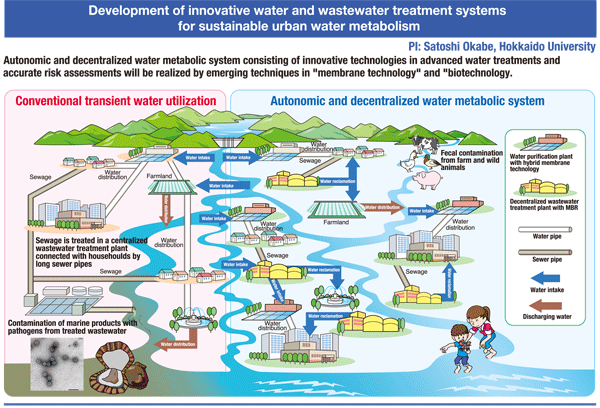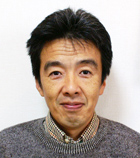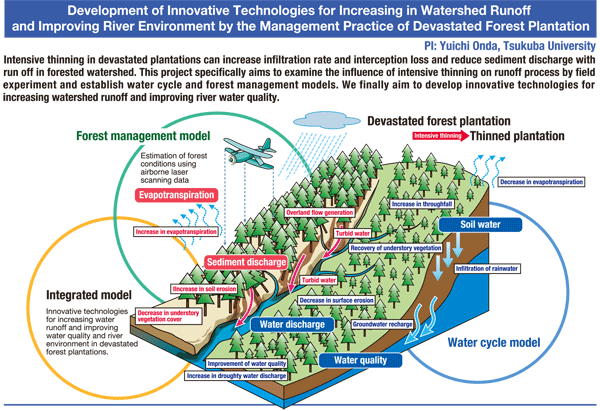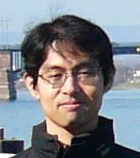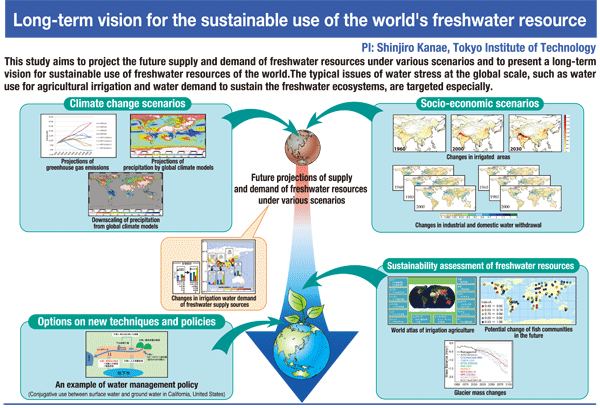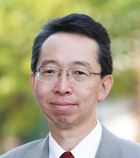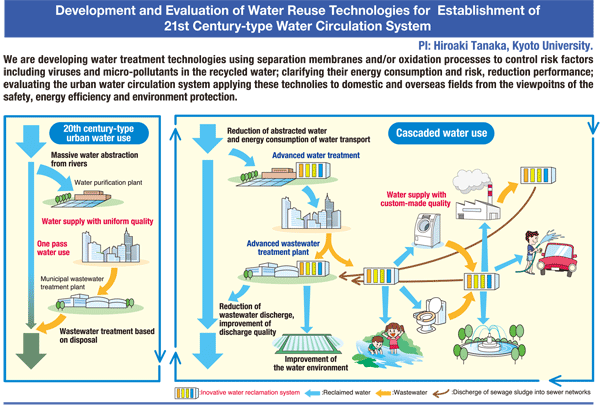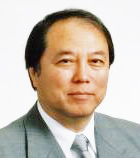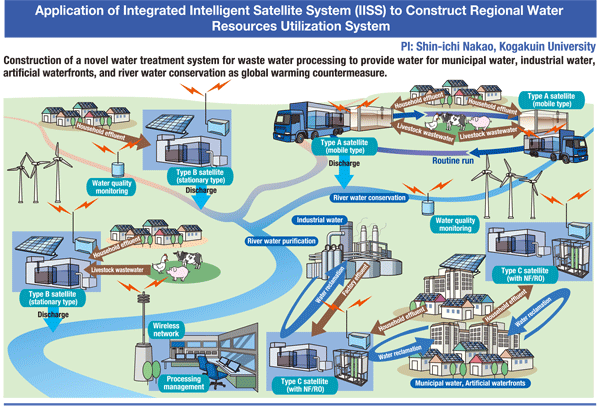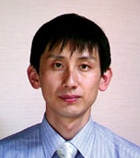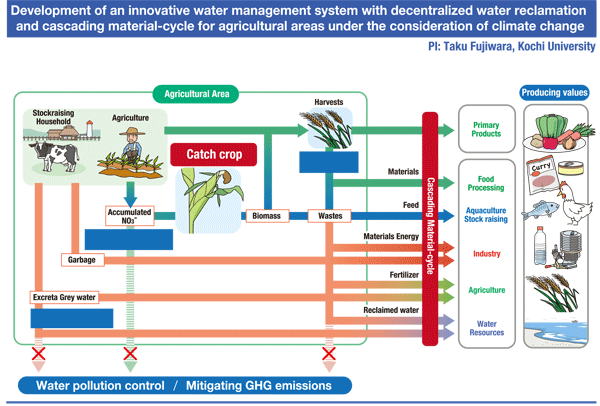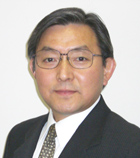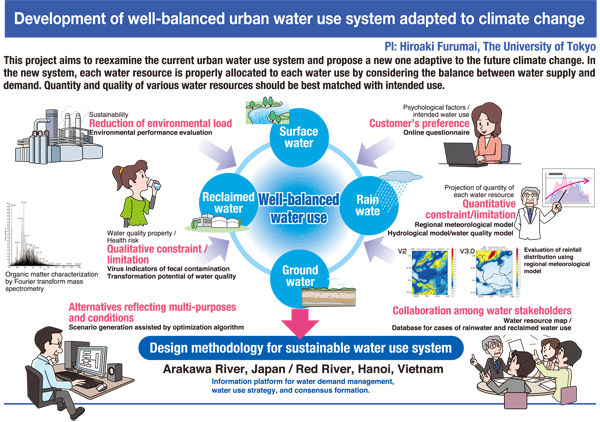| Satoshi Okabe | Development of Innovative Water and Wastewater Treatment Systems for Sustainable Urban Water Metabolism |
|---|---|
| Yuichi Onda | Development of Innovative Technologies for Increasing in Watershed Runoff and Improving River Environment by the Management Practice of Devastated Forest Plantation |
| Shinjiro Kanae | Long-term Vision for the Sustainable Use of the World's Freshwater Resources |
| Hiroaki Tanaka | Development and Evaluation of Water Reuse Technologies for the Establishment of 21st Century Type Water Cycle System |
| Shin-ichi Nakao | Application of Integrated Intelligent Satellite System (IISS) to construct Regional Water Resources Utilization System |
| Taku Fujiwara | Development of an innovative water management system with decentralized water reclamation and cascading material-cycle for agricultural areas under the consideration of climate change |
| Hiroaki Furumai | Development of Well-Balanced Urban Water Use System Adapted for Climate Change |
Development of Innovative Water and Wastewater Treatment Systems for Sustainable Urban Water Metabolism
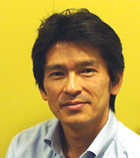
Research Director
- Satoshi Okabe
- (Professor, Hokkaido University, Environmental Engineering and Science, Graduate School of Engineering)
Co-Investigators
- Kotaro Yamazaki
- (Osaka City Waterworks Bureau)
- Kenichi Kobayashi
- (Hanshin Water Supply Authority)
- Nobuhiro Yamato
- (Meta Water Co,. Ltd.)
Pollution and scarcity of water resources are becoming more serious owing to the global climate change and industrialization. Meanwhile, “sustainable and adequate supplies of safe water” is essential for human well-being. To increase the sustainability of safe water supply, it would be necessary to depart from the conventional one-way water usage, a single use and then disposal to environment. A paradigm shift from quantity-based water management to quality-based water management is indeed the key to establishing the sustainable water management. In the emerging paradigm, water must be used efficiently multiple times by cascading from higher to lower quality needs. This emerging paradigm requires establishing autonomous and decentralized water-recycling systems, in which diverse water resources are created, conserved and utilized effectively. In this water recycling system, for example, non-potable water (such as industrial and recreational water) occupying the majority of total demand could be provided by high-grade reclaimed wastewater. It is essential that reclaimed wastewater and polluted natural water for domestic use be of acceptable physical, chemical and microbiological quality. The main concerns are the adverse health risks of pathogens and toxic chemical compounds that are usually present at low concentrations, particularly when preset as components of complex mixtures.
Given this background, first, tools to assess the impact of thousands of trace chemicals on human health must be developed. Second, cost-effective, energy-saving and appropriate water and wastewater treatment technologies must be further explored and implemented. The aim of this project is, therefore, to develop cutting-edge advanced water and wastewater treatment systems using membrane technology, which can be incorporated in the autonomous and decentralized water-recycling systems. In addition, a novel multi-endpoint bioassay will be developed to assess the health risks of micropollutants by applying latest biotechnologies including toxicogenomics and proteomics. Microbiological risks including pathogenic bacteria and viruses are also assessed using molecular based techniques. In the creation of cutting-edge water and wastewater treatment technologies, the advancement and effectiveness are pursued by the combination of the membrane separation and conventional water treatment processes. Finally, the feasibility and reliability of the proposed water and wastewater treatment systems are comprehensively evaluated by operating demonstration plants.
The water quality achieved by the proposed cutting-edge technologies in this project will be dramatically improved compared to the conventional water treatment systems, which make it possible to recycle and reuse the water at different levels as shown in Figure. It is important to appropriately allocate the water and wastewater treatment systems to establish efficient water-recycling systems with minimum energy and costs. The concept of this proposed autonomous and decentralized water-recycling system could be applicable, not only in Japan, but also in developing countries where infrastructures have remained to be established, because it does not require high-tech infrastructures such as systematic sewer networks. This research project will contribute to the increase in international competitive power of Japanese industries in the global market of water businesses reaching 100 trillion yen in next fifteen years.


